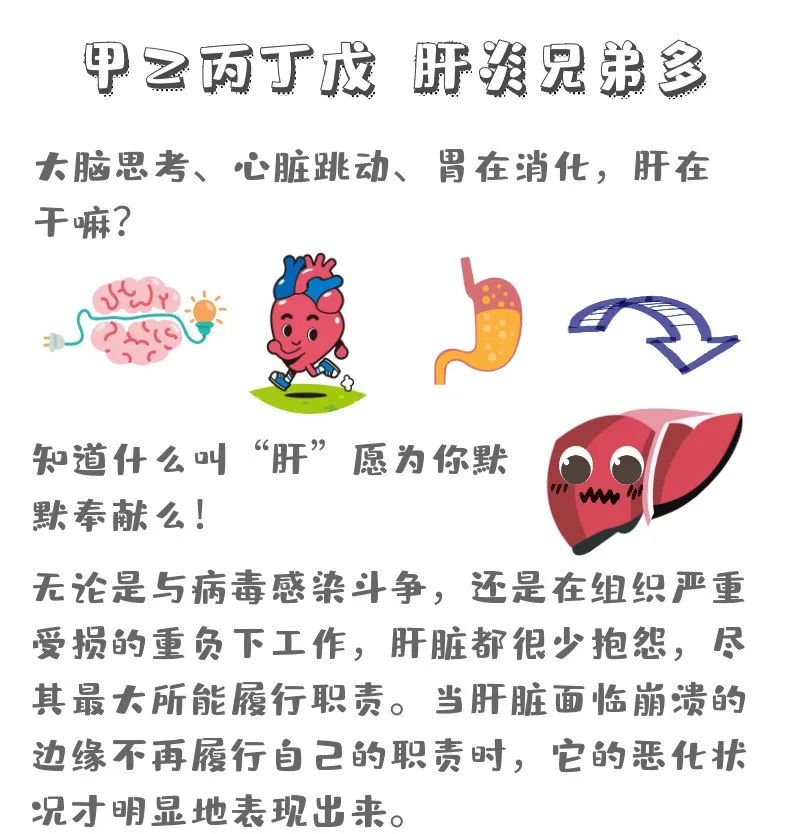Hepatitis can be contagious!Which transmission channels need to be guarded?| World Hepatitis Day
Author:Healthy China Time:2022.07.28
July 28 is World Hepatitis Day. Let's understand hepatitis and love the liver together.
The liver is the largest substantial organs of the human body and the largest digestive organs in the digestive system. It seems to be "hard core", but it is actually fragile, especially in front of the virus. As of now, there are 5 types of liver infection viruses with clear clinical studies, all of which can directly lead to severe liver disease.
Which liver disease is caused by the virus
At present, liver disease caused by viruses mainly refers to viral hepatitis, that is, hepatitis inflammation reactions directly caused by various hepatitis viruses, including hepatitis A, hepatitis B, hepatitis C, Ding liver and pental hepatitis.

Any kind of hepatitis to a certain extent will cause severe damage to the body and even threaten life. my country is a great country B, and about 1/10 of the people are patients with hepatitis B. Long -term suffering from hepatitis B and hepatitis C will cause liver cirrhosis; after liver cirrhosis nodules, liver cancer will occur. Therefore, hepatitis B and hepatitis C are relatively harmful in my country.

How does the virus infringe the liver
When infected with hepatitis A, hepatitis A virus is reproduced and proliferated in hepatocytes. A series of immune response will occur in the body, causing hepatocyte damage, manifested as hepatocyte necrosis and inflammatory response. Hepatitis A virus can be removed by the body's immune response, and generally does not develop into a state of chronic hepatitis, cirrhosis or viral carriers.
The pathogenesis of hepatitis B is very complicated. When infected with hepatitis B virus, hepatitis B virus is copied in hepatocytes. Although hepatocytocytosis is not directly caused, hepatitis B virus genes can be integrated in the host's hepatocyte chromosomes, thereby generating long -term consequences. Hepatitis B's hepatitis B is mainly caused by a series of immune responses of the body. The body's immune response can not only remove the virus, but also cause hepatocyte damage, and even force hepatitis B virus to mutate.
Whether the body's immune regulation function is normal and the strength of the immune response is closely related to the clinical type and transfer of hepatitis B. In immune response and immune regulation, hepatocytes infected with hepatitis B virus were attacked by immune response and destroyed, liver cell death ended infection, and the clinical manifestations were to restore smooth acute hepatitis. Depending on the amount and strength of the virus, the degree of damage to hepatocytes is different, and acute hepatitis is manifested as acute jaundice or acute jaundice -free hepatitis.
If the body's immune function and removal of hepatitis B virus are low, hepatitis B virus is not thoroughly removed, and it may be manifested as asymptomatic chronic hepatitis B virus carriers. Some patients are continuously damaged by liver function, manifested as chronic extension or active hepatitis.
The pathogenesis of hepatitis C and pentaeitis is currently less understandable. Some research results suggest that the pathogenic mechanism of type C and hepatitis C type is also related to the body's immune response. The damage of hepatocytes is mainly caused by the body's immune response.
Research on diced hepatitis shows that diced hepatitis virus has a direct pathogenicity and destruction effect on liver cells. Overlap infection in hepatitis and hepatitis B can cause a large number of diced hepatitis viruses, significantly add damage to hepatocytes, and easily develop into chronic hepatitis or severe hepatitis.

Which transmission channels need to be guarded
The most common form of propagation of hepatitis A virus is dung -mouth pathway, also known as intestinal pathway, that is, contaminated foods and water entering the digestive tract, causing hepatitis A infection. Crusts living in water are likely to be contaminated by hepatitis A virus. When people eat unsustering oysters, clams, oysters and other aquatic products, there is a high risk of hepatitis A virus. The main population of hepatitis A infection is children and adolescents, and winter and spring are the peak period of hepatitis A.
The transmission pathway of hepatitis B/C includes blood transmission, maternal and infant communication, close contact with communication and medical source communication.
(1) Blood transmission: A small amount of blood or blood products containing hepatitis B or hepatitis C virus can cause infection after entering the human body. Blood transfusion, hemodialysis, and organ transplantation can be transmitted.
(2) Maternal and baby vertical transmission: If the mother is a carrier of hepatitis B or hepatitis C virus, there will be a certain probability that it will be passed to the fetus before and after childbirth.
(3) Sexual transmission: Whether or not protective sexual contact with patients infected with hepatitis B virus can spread hepatitis B virus through damaged skin and mucosa.
(4) Medical transmission: The use of polluting or disinfected needles and needles in medical work can cause human infection with hepatitis B or hepatitis C virus.
T -type hepatitis virus and hepatitis B virus have the same pathway, that is, transmission through blood, sexual contact, and maternal and baby transmission. However, the dito hepatitis virus is rarely infected alone, and it is mostly infected with DNA virus such as hepatitis B virus.
Hepatitis is the same as hepatitis A, and it is also transmitted through dung -mouth channels. In the past, water types are the most common, with seasonality, more common in the rainy season or flood, and more common in people with unclean food history. The people are mainly young adults. Pregnant women are prone to high sensitivity, prone to severe pental liver, and high mortality.
special
do not
carry
Awake
It should be emphasized that there is no daily contact with blood exposure, such as working with patients with hepatitis B/C, shaking hands, hugging, living in a room, and even dining and sharing toilets. Theoretically, it will not be infected. However, if you are close contact such as marriage, it is recommended to test the hepatitis virus before marriage. If you are positive, you need to treat it as soon as possible, for yourself, for your lover, and for the health of the next generation.

Author: Wang Xue Dong
Review: National Health Science Popularization Expert Library Expert
Lang Ren, Chief Physician of Hepatobiliary Surgery, Beijing Chaoyang Hospital affiliated to Capital Medical University
Planning: Tan Jia
Edit: Yu Yunxi
- END -
The construction of Shatoujiao Shenzhen -Hong Kong International Tourism Consumer Cooperation Zone is accelerating
In the past few days, the decorative Zhongying Street returned to the square, filled with a lively scene. Hong Kong New Territories Shatoujiao Wharf was officially opened. The reconstruction of the Zh
Daitian ideal transplanting season is wonderful!

Inari Ideal Perium Insert SeasonEclectic work on the paddy fieldSprinkle in the mu...